Although no evidence is to be found in any of the presently known extant Moravian records of the pertinent time period, namely 1776-1779, a myth has long prevailed that Rebecca Langley (1735-1787), the director and master embroiderer of the Moravian Single Sisters’ tambour and embroidery shop, created and directed the making of a beautiful crimson embroidered banner for Count Kazimierz Pulaski (1745-1779). It is said the sisters made it as a token of esteem for his chivalrous protection of them in Bethlehem from rowdy Continental soldiers who were temporarily encamped there; British prisoners briefly gaoled in the former children’s house; and the sick and wounded housed in the Single Brethrens’ house and other family dwellings.
Pulaski landed in America June 1777; fought in Brandywine under Washington; and, as head of the colonial cavalry battled at Germantown and in the winter campaign of 1777-1778. This guidon or standard, attributed to Langley and her fellow sisters, was carried by his light cavalry regiment during its unsuccessful charge at the Battle of Savannah on October 9, 1779 where Pulaski was fatally wounded. Thus, if we were to find supporting evidence in Moravian records at Bethlehem, it would have to be sometime after June 1777 and before October 1779. The Bethlehem Single Sisters’ Diary, 1767-1783 is the only Moravian source that mentions Kasimierz Pulaski, citing his being in Bethlehem, Pa. on April 16, 1778, and again on May 17, 1778. There is, as can be seen below, no mention whatsoever of a banner being designed, or being made by the singles sisters under Rebecca Langley’s direction during this time period.
- ILL. 1a Single Sisters’ Diary, vol. 3: Title Page. Courtesy Moravian Archives at Bethlehem, Pa.
Translation: The Third Volume of the Single Sisters’ Diary in Bethlehem from the Beginning of the Year 1767.
- ILL. 1b1 Single Sisters’ Diary, April 16, 1778, vol. 3, 22. Courtesy Moravian Archives
- ILL. 1b2 Single Sisters’ Diary, April 16, 1778, vol. 3, 23. Courtesy Moravian Archives at Bethlehem, Pa.
Translation: [22] 16th [April 1778, Maundy Thursday] at five o’clock in the evening the first lesson was held. General Pulaski and Colonel Kobatsch were among the listeners.
- ILL. 1c Single Sisters’ Diary, May 17, 1778, vol. 3, 30. Courtesy Moravian Archives at Bethlehem, Pa.
Translation: Sunday, the 17th [May 1778] Mr. Samuel Adams, a delegate to Congress from Massachusetts Bay, Dr. [Isaac] Foster and several other gentlemen enjoyed their day today in Bethlehem, and attended several services, as did also General Pulaski, who, along with a solemn escort from several of his corps, attended the English sermon held by Br. Fries.
However, there are entries in the Single Sisters’ Diary that do mention Rebecca Langley acting on behalf of her sisters as a translator, spokesperson, as well as presenting a gift to a high-ranking Continental Army officer for precisely the same reason as was attributed to Pulaski. There are passages that show the sisters’ concern not only for protection of their persons, but also great concern for their food, and fuel supply. Most of all, there are moments depicted where not only Rebecca Langley, or Susanna von Gersdorf—spiritual and temporal leader of the single sisters, but the entire sisterhood show themselves as loving and benevolent to the very soldiery they are so apprehensive about. Excerpts from the months of December, 1776, and September, 1777 speak for themselves:
- ILL. 2 Single Sisters’ Diary, vol. 3: December 1776. Courtesy Moravian Archives at Bethlehem, Pa
Translation: December 1776. 1st…There was a lot of concern that we will probably be taken over for hospital space. They demanded at first that all of the largest buildings be emptied, even our laundry houses. After much discussion, they finally were satisfied with several family dwellings. Doctor [William] Shippen asked for a nurse to care for the sick, and also expected we would do the ill soldiers’ laundry in our laundry house. Fortunately, God intervened. Sister Mau and her daughters will take over doing the laundry. Even so the daily texts of the last several days were very strange.
4th. The first of the unfortunate men arrived half frozen at the [makeshift] hospital space. On the same evening we sent over some warm soup, and continued to do so up to the 7th since they will also get their noon meals from our kitchen.
15th In the evening just as the sisters were about to go to the evening meal, we were frightened by a reckless neighbor whom we didn’t even know. He came into the house with his musket, and after much interrogating, we learned that he had just wanted to pay a visit. Susel [Susanna von Gersdorf] showed him the way out. During the worship service, amidst much racket, people came to fetch our flatboat to Easton in order to bring across 4000 of General [Charle’s] Lee’s men, who are headed for Bethlehem to make camp for a day of rest, and as we heard afterwards, get into all kinds of mischief. We put our trust in the watchful and protective Guardian of Israel, and entrusted our lives, souls and community to Him, Who is able to keep us from all harm and danger…
17th General [Horatio] Gates arrived with 500 men. He visited, along with a number of other officers, in our house during the afternoon. An express courier from General Sullivan arrived with an order for Brother Ettwein to make place for the 4000 men who would be arriving in a few hours. Brother Ettwein approached General Gates who immediately sent his Adjutant away from the house with the order that if the men were still some distance from Bethlehem, they were to take a different route. He was, however, too late. Around 4:00 pm General Sullivan arrived with the 4000 soldiers, who in reality are under the command of General [Charles] Lee, a man whom God in His mercy gave into the hands of the British two days ago (from the lips of his own officers here in Bethlehem). We asked General Gates to give us two special guards to protect us from all harm in this noise and confusion, which he immediately granted. We immediately made provisions for our sisters and girls outside of town to be brought to our house to sleep. Brother Ettwein soon brought General Sullivan with several of his immediate officers into the house. Initially he appeared very haughty, but in the end became quite modest. Our sisters had to sing and play the zither for him. Our special guards changed every three hours. After they were relieved, they went for something to eat in Sister Liesel’s room. An English-speaking sister kept watch all night so that she could give them warm wine or coffee, along with a snack through the window. We can scarcely thank the Savior enough for their faithfulness and model behavior for the three days and two nights they kept watch.
18th From morning ‘til late at night we received continual visits from officers. We counted at least three hundred of them, and thanked God that everything went so smoothly. The one hundred or more fires round about Bethlehem made a frighteningly beautiful sight, but also provoked much concern since they burned all the fences.
19th Early in the morning General Sullivan and his men took leave. Sister Susel [Susanna von Gersdorf] gave the twelve men who had been our special guards a tour of the house. Many, who had tears in their eyes, thanked and assured us they would never forget the kindnesses we had shown them. Rebecca Langley conveyed our compliments to General Gates and presented him with a very beautiful pocketbook as a gift, which he graciously accepted. In the afternoon Gates left with his people very well disposed towards the Brethren Our sisters outside of Bethlehem were thankful that everything had gone so well with no mishaps.
- ILL. 3 General Horatio Gates, ca. 1794 Gilbert Stuart Portrait. Public Domain.
- ILL. 4a Single Sisters’ Diary, vol. 3: September 1777. Courtesy Moravian Archives at Bethlehem, Pa.
Translation: September [1777]
6th Rachel Edmonds from Bartows moved into the [single sisters’] house, and her three eldest children into the Children’s House since the 218 English captured soldiers, along with several wives and children, are scheduled to be kept in the former Children’s House. The latter arrived on the 7th [September] at noon under a guard of one hundred fifty men.
9th A House Conference was held. The general dearth was great everywhere. There is a lack of wood, and no one to deliver it. Everything within the community is earmarked for the soldiers. Food increased again to 1/. per week.
10th Pre-communion talks began with Sisters Susel [Susanna von Gersdorf], Esther and Betsey.
13th We celebrated the congregational communion without any disturbance. The Catholic Baumgertner was readmitted.
16th We held the liturgy for the sisters.
19th Totally unexpectedly a letter came from Doctor [William] Shippen, which was immediately read during the communion service since the largest houses are desired to use as a hospital for around 1000 sick and wounded. Immediately afterwards it was decided in the elders’ conference, without additional counsel available, to empty the single brothers’ house, as well as several family houses with the hope that Our Savior will retain both the widows and us in our respective houses. There are no words to describe how our sisters sobbed, and begged our Savior, Who heard us in our need, and consoled us.
20th Sister Susel [Susanna v. Gersdorf] laid it upon each sister’s heart during the morning blessing to ask the Savior
- ILL. 4b Single Sisters’ Diary, vol. 3: September 1777. Courtesy Moravian Archives at Bethlehem, Pa.
20th [September 1777] [new leaf] that He might keep us within our temple/choir house away from the noise of the world, and most of all that He might protect us from the terrors and temptations, and keep our hearts focused solely on Him. This she faithfully prayed upon her knees amidst shedding of many thousands of tears, and thus our Hearts were consoled.
21st Sunday, the wounded and sick soldiers moved into the single brothers’ house, and several members of Congress also arrived.
22nd In the morning Brother Ettwein and the members of Congress came into our house. We had a message that they wanted to spend their sojourn here. Sister Susel [Susanna v. Gersdorf] presented her concerns to them in German, and Sister A.[nna] R.[ebecca] Langley translated them into English, namely that she wanted an assurance that no one would expect the sisters to move out of their house, for in so doing their entire way of life would be ruined. This the gentlemen scarcely expected, and they hardly knew how to answer. Mr. Henry Laurens spoke with Brother Ettwein privately in a very cordial way, and pointed him to Mr. Richard Lee, to whom Brother Ettwein turned, and with commiserating tears in his eyes repeated our plea. The gentlemen found the house to their liking, and this afternoon via Br. Ettwein they sent over the following news.
[This is the original English as penned by the single sisters’ diary scribe.]
Bethlehem 22 September 1777.
Having here observed a humane and diligent attention to the sick and wounded and a Benevolent disire to make the necessery provision for the relief of the distressed as far as the powers of the Brethren enables them we desire that all Continental Officers may refrain from disturbing the persons or property of the Moravians in Bethlehem, and perticularly that they do not desturb or molest the Houses where the Women are asambled. Given under our hands at the Time and Place above mentioned.
Richard Henry Lee William Duer Conrad Harnett Henry Laurenz
Benj. Harrison, Joseph Jonds, John Adams, Henry Marchant,
Nath. Folson, Richard Law, William Williams Nathan Broundson
John Hancock, Samuel Adams, Elyeth Dyer Jacob Duane.
Our hearts were full of praise and thanksgiving before the Lord, Who holds all men’s hearts in His hands, and takes special care of His single sisters choir. Hundreds of wagons arrived with baggage, all of which will go out to the family houses. We worried on account of our sisters, young girls and children. In the afternoon all of the sisters went to help with the putting up of the potatoes and white cabbage so they aren’t stolen. During the evening blessing, we commended ourselves to the Protector of Israel.
23rd Sister Susel [Susanna v. Gersdorf] read a talk by Brother Joseph [Spangenberg] from the congregational news. On the 24th 700 wagons with women, children, and many hundreds of soldiers arrived. They put up tents all around us, on the low land and in the orchard. The horrible fires, which consumed all the fences, were ghastly to behold. Besides this, great want prevailed, along with no water except what one could bring from the spring. Thus our sisters for the most part fetched the water in the laundry house for the rooms. The water for the kitchen had to be brought by wagon. The flax house on the edge of our wash house was used as a depot for powder and lead, and guarded by sentries. This again caused embarrassment for our sisters, who every morning had to go into the wash house. Thus Sister Susel [Susanna v. Gersdorf] went over there, and asked someone who could speak German to ask the others to allow the sisters, who would come by with a lantern every morning at 4:00 am, to pass by safe and sound. This soldier promised whenever possible to keep the watch himself at this time, which he faithfully did, and he also promised not to burn the fences.
25th Members of Congress, including Mr. Hancock and Samuel Adams visited our house and were shown around. They were also asked to protect us, and since they were shown the signed assurance from 22 September, likewise added their names.
26th The 218 English prisoners, who were very staid, and to whom Mr. Wab [Captain Thomas Webb] preached several times in the house grounds, left under heavy guard. Sister Susel [Susanna v. Gersdorf] conducted the communion quarter-hour, and the Savior’s pronounced presence as we unburdened our hearts at His feet was indescribable.
27th At the house conference today there were all kinds of opportunities to thank the Savior for His preserving us. Each was asked, according to her capabilities, to keep watch, and to report everything immediately to the right place.
- ILL. 5 Moravian single sisters’ wash house located on Sand Island near the sawmill. R. Grider collection, f.16.2. Courtesy Moravian Archives at Bethlehem, Pa.
In 1825, Henry Wadsworth Longfellow memorialized Pulaski’s Banner with a poem entitled “Hymn of the Moravian Nuns of Bethlehem,” and it has been suggested that this fueled the imaginations of those who created a charming, and romantic, but fictional account of the banner. In 1845, Edmund R. Peale donated the actual relic to the Maryland Historical Society, then in its second year of existence. It is still there in storage, and can seen by special appointment. Rufus Grider, a Moravian teacher and artist, drew the front and back from the original in 1871, downscaling it to ¼ of its actual size, and included a synopsis of the popular Moravian single sisters tale. Whether true or not, the story is so engrained in American traditions, it will always be told.
- ILL. 6a Pulaski Banner, front: R Grider collection, f. 29.12. Courtesy Moravian Archives at Bethlehem, Pa.
Translation: Non Alius Regit = No other governs.
- ILL. 6b Pulaski Banner, back: R. Grider collection, f.29.12. Courtesy Moravian Archives at Bethlehem, Pa.
Translation: Unitas Virtus Forcior [sic] = Union makes valor stronger [Letter “C” should be a “T.”]
Perhaps somewhere on an attic or in an archival storage space there is yet a manuscript or two that will support the suggestion that Pulaski during his brief appearances in Bethlehem was so taken with the Moravian sisters’ gorgeous embroidery that he ordered the famed banner, and that Rebecca Langley designed and directed her fellow embroiderers in its creation. Master tambour embroiderers could stitch more quickly than by other traditional embroidery methods for they were using only one stitch. This was accomplished by stretching fabric between two round fitted hoops much like the head of a small drum or tambour; and using a special hook to punch through the material, catching the thread from beneath and drawing it up to create a linked, chainlike stitch. By working rows of chained stitches closely together they could produce shaded color work with great depth and variety. An actual example featuring a pin cushion with tambour work done in silk, linen, cotton, and wool ca. 1790-1810 in Bethlehem, Pa. is preserved in the Winterthur textile collection.
- ILL. 7 Pincushion: 1981.0093, tambour work, Moravian/Bethlehem ca. 1790-1810. Courtesy of Winterthur
Unlike Pulaski’s banner, we don’t know the whereabouts of the beautiful pocketbook Rebecca Langley presented to the Continental Army General Horatio Gates on December 19, 1776, but it might have been similar to this ca. 1770 pouch with tambour work on silk and leather. What we do know is that the documented story of Rebecca Langley, Susanna von Gersdorf, and the
- ILL. 8. Pouch: 1960.0172, tambour work ca.1770-1820. Courtesy of Winterthur
Moravian single sisters’ experiences in Bethlehem from 1776-1779 is not only full of surprises, great and small deeds, valor, chivalry, kindness, caring, and Christian love, but also is totally true!
- ILL. 9. Curator Mary Brown with Becky Langley Doll. Moravian Museum of Bethlehem. Courtesy AlyssumArts
BIOGRAPHICAL THUMBNAILS
John Ettwein (1721-1802) and his wife came to America in 1754, and served as Moravian missionaries to the Delaware Indians, first at Friedenshütten near Wyalusing, and then at Friedensstadt on the Beaver River in southwestern Pennsylvania. During the Revolutionary War, he was the chief spokesperson for the Moravians in Pennsylvania with members of the Continental Congress and other dignitaries. After being consecrated a bishop in 1784, he became the head of the Moravian Church in America.
Dr. Isaac Foster (ca. 1740-1781) was a physician, and a delegate to the first provincial congress of Massachusetts in 1774. He was appointed a surgeon in 1775, and for several months was the head of the military medical department. At Washington’s request Foster was elected by Congress in April 1777 as Deputy Director-General of the Hospitals for the Eastern District. He retired from public life in 1780 due to poor health, but did not resign his commission. He died in 1781.
Horatio Gates (1727-1806), a retired British soldier, served as an American major general during the Revolutionary War. When it was clear that the English would not be attacking Ticonderoga in 1776, Gates marched some of the army to join Washington in Pennsylvania, to where they had withdrawn after the fall of New York City to the British.
Susanna (‘Susel’) von Gersdorf (1731-1805) was the spiritual and temporal head of the Single Sisters in Bethlehem from 1764-1784, having replaced Anna Rosina Anders in 1764. She later filled the same position in Neuwied (1789-1795) and Ebersdorf (1795-1805).
Rebecca Langley (1735-1787) was born in Northampton, England on September 6, 1734. Her father was James Langley, a successful merchant involved in many ventures, and her mother Rebecca, née Waston. Both were Presbyterians, and followers of Rev. Philip Doddridge, an independent religious thinker and writer. They came to know the Moravians, especially Brother Jacob Rogers, and when Rebecca was eleven moved to London to be closer to the Unitas Fratum’s members. Upon her mother’s death in 1747, Mr. Langley brought his daughter to a very famous boarding school where she spent three years receiving an upper class education. Rebecca probably had begun to learn practical and decorative sewing at home, but it was more than likely she acquired the requisite skills in tambour work and other fine stitchery at this private finishing school. Upon completion of her studies, the headmistress retained her as an assistant in the school. During this time her father emigrated to the American colonies to try his luck, and settled in Boundbrook, New Jersey. On June 14, 1753 Rebecca and her youngest sister Erdmuth went on board the Moravian-owned ship “the Irene,” and were specially attended to by its Captain Nicholas Garrison (1701-1781) and his wife. Both girls also got to know Peter Boehler, and other Moravians during their three month sea voyage. They landed in New York in the beginning of September1753. Rebecca briefly stayed with a famous New York merchant, and then, along with Erdmuth, was brought to Boundbrook by her father. The eighteen-year-old was so unhappy in the rural environment that she found an excuse to return to the merchant family in New York where she stayed for three months, enjoying all the worldly delights the city had to offer. Upon her return to New Jersey, George Whitefield, the preacher famous for the “Great Awakening” movement both in Europe and America, came from Philadelphia and visited in the Brunswick area where Rebecca heard him preach quite often. The Garrisons also came through the area about the same time inviting her to visit them in Bethlehem. The influence of both prompted the young woman to reconsider her spiritual state. Her father left once more to try his fortune, this time in the West Indies, and placed his daughters in the home of one of his merchant friends in Brunswick, NJ. This man was quite taken with Rebecca. He almost immediately found a work opportunity for Erdmuth, but to Rebecca he offered his house. It isn’t clear if this means as housekeeper or wife. However, Becky Langley does say that the combination of all of these experiences jolted her into the reality that she had to choose a definite direction for her life that would take care of her temporal, as well as spiritual needs. She chose a life with the Moravians, arriving in Bethlehem on June 19, 1755. She must have been very elegant in appearance and ways for most of the Moravians didn’t think she would fit into their simple lifestyle. Rebecca convinced them to take her, and was baptized by Peter Boehler August 24, 1755; became a candidate for communion on June 10, 1756. On January 1, 1757 she received permission to take communion, and on January 21st partook of the Lord’s Supper for the first time. Her confirmation on September 3, 1758 forever sealed her commitment to the life of a single sister. The scrivener who completed Rebecca’s memoriam mentions that she was consecrated as an acolyte on the same day as her confirmation, serving her fellow Moravians lovingly and with great joy. When the communal economy was dissolved in 1762, and the sisters had to found businesses that would support their economic needs, Rebecca’s creative talents as a master embroiderer proved especially beneficial. She also was convivial, dealt well with strangers, and was adept in business matters, all making this energetic woman the perfect person to direct the tambour and embroidery shop in the sisters’ house. Her younger sister Erdmuth also came to Bethlehem, and became a single sister, but always stood in the shadow of Rebecca. In 1778 James Langley came to Bethlehem in his seventieth year as a broken and ill man. His daughters lovingly cared for him for fourteen weeks, and saw him die as a redeemed sinner of the Lamb. Rebecca Langley first showed signs of illness in 1785, periodically spending time in the sisters’ sick room where she was lovingly cared for. In the summer of 1787 she went to Philadelphia for several weeks where she hoped to regain her health among friends and acquaintances. However, on her trip back to Bethlehem she caught a cold, and never quite recovered. Rebecca occupied the sick room from July until her death on October 2, 1787. Buried on 5 October, she was survived by Erdmuth, and a brother James, who lived in London.
Henry Laurens (1724-1792) was an American merchant and rice plantation entrepreneur from South Carolina. A delegate to the Second Continental Congress, Laurens succeeded John Hancock as President of the Congress. He was a signatory to the Articles of Confederation and was president of the Continental Congress when the Articles were passed on November 15, 1777.
Charles Lee ( 1731-1782 ) British-born Major Gen. Charles Lee joined the forces of Geroge Washington’s Continental Army in 1775. A competitive and rash man, he openly challenged Washington’s authority and capabilities and his arbitrary decision-making often put the Continental Army in precarious positions. In September 1776, after the British had withdrawn from the southern colonies, Washington ordered him to rejoin the main U. S. Army under his command in Pennsylvania. Lee intentionally moved his troops as slowly as possible so as not to be accused of not following orders. During this leisurely march, he was captured December 13, 1776 by the English at Basking Ridge, near Morristown, N. J., and taken to New York City where he remained prisoner until late December, 1777, finally being exchanged in Philadelphia for British Maj. Gen. Richard Prescott on April 21, 1778. After his capture, General Sullivan took command of Lee’s forces and marched them to join Washington in time for the Battle of Trenton on December 26, 1777. Charles Lee’s December 1776 capture by British troops, as well as his retreat during the Battle of Monmouth, led to a court-martial and removal from the army.
John Sullivan (1740-1795) served in the Revolutionary War as a major general; proved his bravery and loyalty at the Battle of Trenton, NJ on December 26, 1776; was a delegate from New Hampshire to the Continental Congress; Governor of New Hampshire; and a U. S. Federal judge.
Thomas Webb (1724-1796) was born in the west of England, and fought under the British in North America during the French and Indian War. He was converted by a Moravian minister, but found his spiritual home among the Methodists. Having sold his commission in 1766, Webb crisscrossed between America and England. However, in April 1773 he returned to America, newly married and as a civilian. Acting on a report from an American agent, Webb was arrested as a British spy and brought to Bethlehem where he ministered to other English military internees.
My thanks to Linda Eaton and Roberta Weisberg of Winterthur; Charlene Donchez Mowers, Lindsey Jancay, and Mary Brown of Historic Bethlehem Inc.; Paul Peucker, and Tom McCullough of the Moravian Archives at Bethlehem, Pa; and Allison Tolman of the Maryland Historical Society
Blog Post including transcriptions; translations; and photo images excepting Winterthur © 2015 Del-Louise Moyer






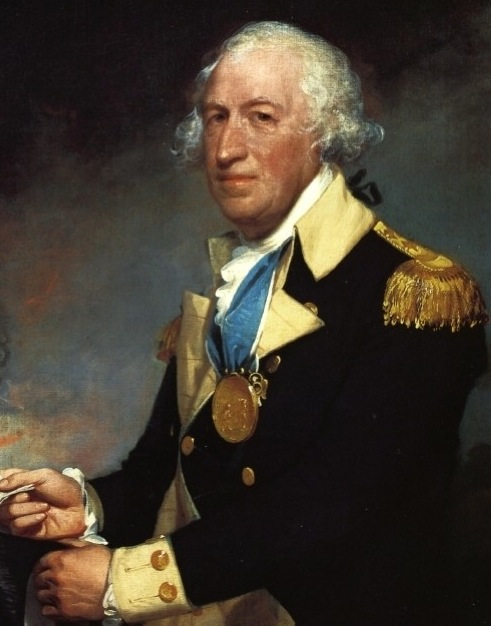
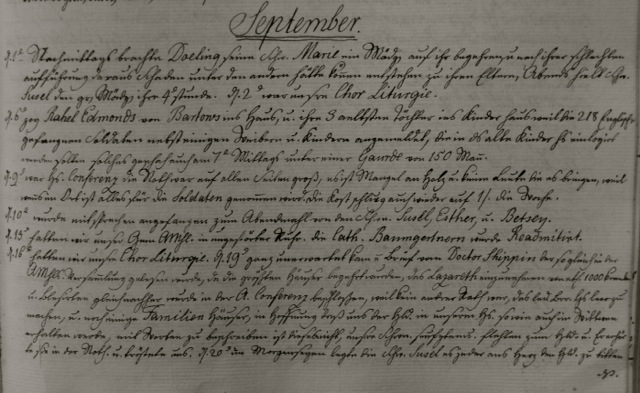
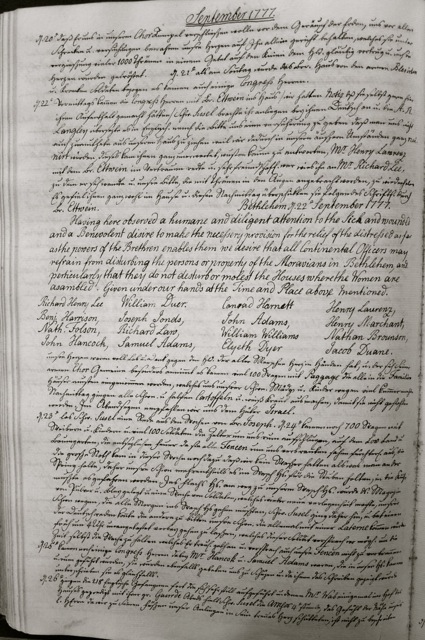
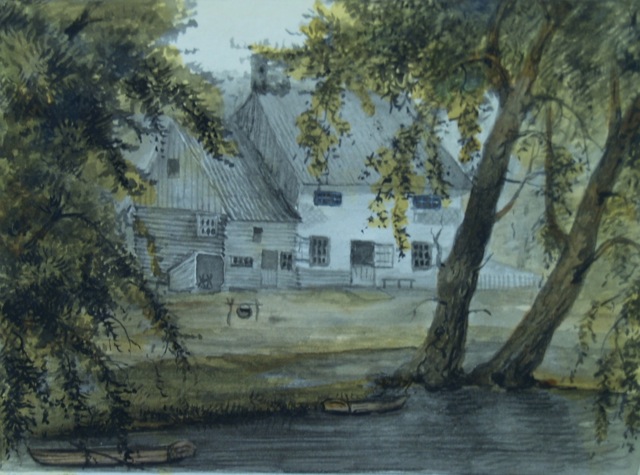


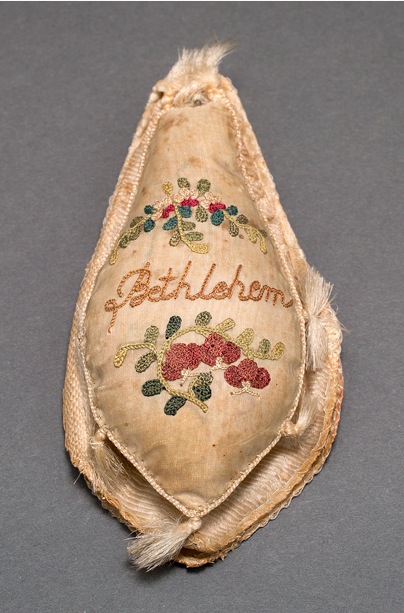
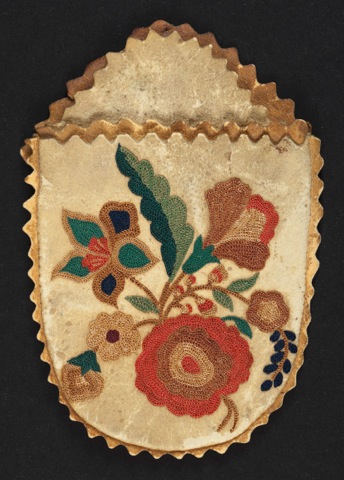

What a wonderful article. I noticed Dr Shippen was mentioned. Is this the same Dr Shippen related to Shippen Manor in Oxford, NJ?
LikeLike
Thanks, Lorna. The Dr. William Shippen mentioned in the article is the brother of Joseph William Shippen, who lived at the Shippen Manor in Oxford Furnace, NJ until his death in 1795. According to a 9/19/1777 Bethlehem Diary entry of a request Dr. [William] Shippen sent to requisition the Moravian communal buildings as hospitals, he was the “Director General of the Continental Hospital.” Mention is made in Proceedings of the New Jersey Historical Society “Sketches of New Jersey Shippens” (vol. 1, Jan., 1916, pp. 42-43) that “Joseph William Shippen was a paymaster in the Bethlehem Army Hospital during the Revolutionary War. At this same Hospital his brother, Dr. William Shippen, Jr., served as a member of staff and Medical Director of the U. S. Army, 1779.”
LikeLike
I found the translation exciting…Thank you for all of your hard work. The embroidery sounds like an early hand form of sewing that the sewing machine later copied…or tried to!
LikeLike
Very interesting. I knew most of the “characters” on the military side, but nothing about their visits to the hospitals. Excellent article. Thanks for sharing.
LikeLike
Jack, Thank you for your comments. Today when we look back, the political and military personalities who visited or sojourned in Bethlehem, Pa. during the Revolutionary War form a veritable “Who’s Who” list. There were, however, also the thousands of unnamed wounded and sick who either died or recuperated in the single brethren’s house and/or some of the family houses. There are many manuscripts at the Moravian Archives waiting to tell more of the story!
LikeLike
What a package! Del Louise .your work and devotion on whatever you touch is nothing but the very best. Such a wealth of information brought to the brighter light. Thank You for sharing
LikeLike
Loved your comment about the nameless souls who sojourned at the hospital/house. How grateful they must have been for the sisters’ kindness. Wise choice of location. Perhaps a harkening back to the hospices of old, in the time of the Crusades, when there was a hospital set up in Malta…We can not know what is not written but someone must have harkened back to “wouldn’t it be nice if” or an unwritten hero who took it upon himself to make things happen…With all those people in the area grabbing credit, being public, I like to think of the hidden person who made things happen but sought no notoriety. It could have been a sister?
Love , Lizzie
LikeLike
I am awed by the careful research behind this article and its excellent presentation.
Many thanks
LikeLike
Del, thank you so much for this research and post. I didn’t know any of this and your research and presentation is always the best! Excellent!
LikeLike